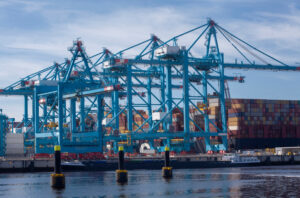PTI has recently spoken to Jean-Philippe Deby, Business Development Director – EMEA, in an exclusive interview in which he articulates the security threats that are putting ports at risk, as well as the pro-active solutions available to counter these threats.
Hi Jean-Phillipe, what do you see as the main security threats for ports?
Ports and harbours are highly regulated, so access control and surveillance is a critical requirement. To monitor boat and facility traffic—and watch for threats or intruders—ports must combine perimeter detection with video surveillance and access control. Extending these fundamental elements of security with video analytics, for example, is helping security directors get more return-on-investment (ROI) from their security platform.
(Source: Freeport)
A modern physical IP-based security system is unified to combine how video surveillance, access control, automatic license plate recognition (for lorries and automotive traffic) is managed from one central operations centre. For example, multiple cameras throughout the port facility are able to capture all movement and activities on video. Video footage is archived either on-premises or in the Cloud, and can be accessed in the event of an investigation. Access control can be used in conjunction with video surveillance, to track all authorized movement through a facility, and immediately terminate access rights when an access badge is reported lost or stolen. Validation with the security controller, can also provide temporary access to authorized parties. Genetec is committed to offering smart utilization and open-platform extensibility for its IP security systems to assure optimum flexibility, functionality and ROI to its port customers.
Video surveillance seems to be a reactive method for securing ports. Are there any pro-active ways for detecting potential threats?
While a unified IP-security platform can quickly alert a port facility to react to an intrusion or threat, it is the passive, on-going surveillance and video pattern analytics that offers substantial early detection and notification. After the initial investment of IP cameras, access control hardware, and a unified security platform to manage and store data, ports are now able to maximize their investment by extending the capabilities of these cameras with new features, such as video analytics. For example, a good video analytics program can ‘learn’ when there is a lot of movement and when there is lower traffic. Any changes to these established patterns will initiate an ‘alert’ stating that something out of the ordinary is occurring, and worth attention. Extending the capabilities of the cameras through the security center means better efficiency and a higher chance that intruders or threats will be recognized.
(Source: Freeport)
How important is training for port and terminal staff to be able to utilise this technology?
Training is very important, naturally, and port security agents are highly specialized in their role. Because there are so many elements to securing a port—from perimeter detection sensors to cameras and analytics, access control systems and ANPR technology for ground transport—the more unified and centralised a security operations centre is, the more effective a port security agent can be. Training can be streamlined when all systems feed into one security management interface. With the high-camera requirements in a port, security executives must rely on an interactive mapping system within the security operations center to locate and pinpoint where all the cameras are deployed and which direction they are monitoring. Once again, if this is unified within the security center, reaction and interception time is accelerated. By combining perimeter detection of a port with video surveillance, access control and ANPR, with open-platform support for features like analytics, camera mapping and management, inter-facility communications and world class training, ports can realize heightened situational awareness to quickly respond to threats, manage access and mitigate intrusions.










